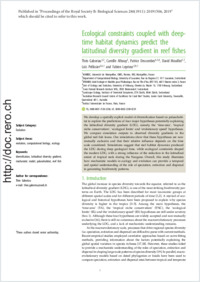Ecological constraints coupled with deep-time habitat dynamics predict the latitudinal diversity gradient in reef fishes
- Gaboriau, Théo MARBEC, Université de Montpellier, CNRS, Ifremer, IRD, Montpellier, France - Department of Computational Biology, University of Lausanne, Rue du Bugnon 27, 1011 Lausanne, Switzerland
- Albouy, Camille IFREMER, Unité Ecologie et Modèles pour l'Halieutique, Rue de l'Ile d'Yeu, BP21105, 44311 Nantes cedex 3, France
- Descombes, Patrice Unit of Ecology and Evolution, University of Fribourg, Chemin du Musée 10, 1700 Fribourg, Switzerland - Swiss Federal Research Institute WSL, 8903 Birmensdorf, Switzerland - Landscape Ecology, Institute of Terrestrial Ecosystems, ETH Zürich, 8044 Zürich, Switzerland
- Mouillot, David MARBEC, Université de Montpellier, CNRS, Ifremer, IRD, Montpellier, France - Australian Research Council Centre of Excellence for Coral Reef Studies, James Cook University, Townsville, Queensland 4811, Australia
- Pellissier, Loïc Swiss Federal Research Institute WSL, 8903 Birmensdorf, Switzerland - Landscape Ecology, Institute of Terrestrial Ecosystems, ETH Zürich, 8044 Zürich, Switzerland
- Leprieur, Fabien MARBEC, Université de Montpellier, CNRS, Ifremer, IRD, Montpellier, France - Institut Universitaire de France, Paris, France
-
25.09.2019
Published in:
- Proceedings of the Royal Society B: Biological Sciences. - 2019, vol. 286, no. 1911, p. 20191506
English
We develop a spatially explicit model of diversification based on palaeohabitat to explore the predictions of four major hypotheses potentially explaining the latitudinal diversity gradient (LDG), namely, the ‘time-area’, ‘tropical niche conservatism’, ‘ecological limits’ and ‘evolutionary speed’ hypotheses. We compare simulation outputs to observed diversity gradients in the global reef fish fauna. Our simulations show that these hypotheses are non-mutually exclusive and that their relative influence depends on the time scale considered. Simulations suggest that reef habitat dynamics produced the LDG during deep geological time, while ecological constraints shaped the modern LDG, with a strong influence of the reduction in the latitudinal extent of tropical reefs during the Neogene. Overall, this study illustrates how mechanistic models in ecology and evolution can provide a temporal and spatial understanding of the role of speciation, extinction and dispersal in generating biodiversity patterns.
- Faculty
- Faculté des sciences et de médecine
- Department
- Département de Biologie
- Language
-
- English
- Classification
- Biological sciences
- License
-
License undefined
- Identifiers
-
- RERO DOC 327361
- DOI 10.1098/rspb.2019.1506
- Persistent URL
- https://folia.unifr.ch/unifr/documents/308327
Statistics
Document views: 116
File downloads:
- pdf: 161
